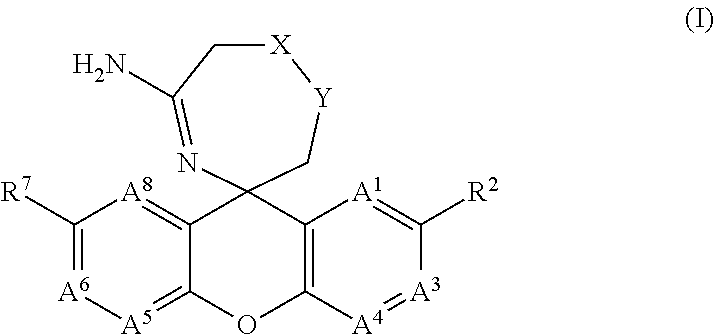5-amino-oxazepine and 5-amino-thiazepane compounds as beta secretase antagonists and methods of use
a technology of beta secretase and thiazepane, which is applied in the field of pharmaceutical active compounds and pharmaceutical compositions, can solve the problems of loss of cognitive function, diminished cognition of self, family and friends, and beta secretase cleavage site thought to be a rate-limiting step in a-beta production
- Summary
- Abstract
- Description
- Claims
- Application Information
AI Technical Summary
Benefits of technology
Problems solved by technology
Method used
Image
Examples
example 1
Intermediate A
[0383]
Synthesis of 7-bromo-3-chloro-6′,7′-dihydro-2′H-spiro[chromeno[2,3-c]pyridine-5,3′-[1,4]oxazepin]-5′-amine
[0384]Step 1: A RBF was charged with 2,5-dibromobenzoic acid (1244 g, 4.44 mol), 5-hydroxy-2-chloropyridine (663.3 g, 5.12 mol) and cesium carbonate (2893.3 g, 8.88 mol). The resulting mixture was stirred for 20 minutes under nitrogen atmosphere at which time copper (I) trifloromethanesulfonate toluene complex (59.7 g, 0.115 mol), toluene (9 L) and EtOAc (39 mL) were added in sequence. The resulting suspension was heated to 105° C. for 2 h and cooled to RT. The toluene was decanted and water (8 L) and EtOAc (8 L) were added to the residue. The mixture was stirred until the solids were completely dissolved. The organic layer was separated and the pH of the aqueous layer was adjusted to pH 2˜3 with 6N HCl. This mixture was then extracted with EtOAc (3×5 L). The combined organic layers were dried over Na2SO4, filtered and concentrated to give 1.28 kg of 5-bromo-...
example 2
Method 1: Using Intermediate A
[0390]
Synthesis of (E)-7-(2-fluoropyridin-3-yl)-3-(2-fluoropyridin-4-yl)-6′,7′-dihydro-2′H-spiro[chromeno[2,3-c]pyridine-5,3′-[1,4]oxazepin]-5′-amine
[0391]Step 1: A vial was charged with (E)-7-bromo-3-chloro-6′,7′-dihydro-2′H-spiro[chromeno[2,3-c]pyridine-5,3′-[1,4]oxazepin]-5′-amine (280.9 mg, 0.712 mmol), 2-fluoropyridin-3-ylboronic acid (150 mg, 1.068 mmol), Pd(AmPhos)2Cl2 (25.2 mg, 0.036 mmol), and potassium phosphate (453 mg, 2.135 mmol). The vial was flushed with Ar (g), then 1,4-dioxane (2669 μL) and water (890 μL) were added in sequence. The vial was sealed and heated in a microwave reactor for 20 min at 90° C. The mixture was extracted with EtOAc (3×), and the combined organic extracts were concentrated. The crude product was purified by chromatography on silica gel (0-10% MeOH / DCM) to give (E)-3-chloro-7-(2-fluoropyridin-3-yl)-6′,7′-dihydro-2′H-spiro[chromeno[2,3-c]pyridine-5,3′-[1,4]oxazepin]-5′-amine as a white solid.
[0392]MS m / z=411.0. Calc...
example 3
Intermediate B
[0394]
Synthesis of (E)-5-amino-7′-bromo-4′-fluoro-6,7-dihydro-2H-spiro[[1,4]oxazepine-3,9′-xanthen]-2′-ol
[0395]Step 1: A dry 100 L glass jacketed reactor equipped with an addition funnel, reflux condenser, solids addition system and temperature probe was charged with 2,5-dibromobenzoic acid (2685 g, 9.6 mol) and copper (I) triflate toluene complex (2:1, 50.0 g, 0.2 mol). Toluene (30 L) and EtOAc (20 mL) were then charged, followed by 2-methoxy-4-fluorophenol (1500 g, 10.6 mol). With vigorous stirring cesium carbonate (6258 g, 19.2 mol) was added in portions. The mixture was heated to 90° C. for 4 hours. The mixture was cooled to 35° C. and water (15 L) was added. After 15 minutes of stirring the phases were sping and the aqueous phase was washed with toluene (7.5 L). With stirring, EtOAc (15.0 L) was added to the rich aqueous phase, followed by 6 M HCl (5.6 L) keeping the internal temperature below 30° C. The layers were separated and the organic layers were dried over...
PUM
 Login to View More
Login to View More Abstract
Description
Claims
Application Information
 Login to View More
Login to View More - R&D
- Intellectual Property
- Life Sciences
- Materials
- Tech Scout
- Unparalleled Data Quality
- Higher Quality Content
- 60% Fewer Hallucinations
Browse by: Latest US Patents, China's latest patents, Technical Efficacy Thesaurus, Application Domain, Technology Topic, Popular Technical Reports.
© 2025 PatSnap. All rights reserved.Legal|Privacy policy|Modern Slavery Act Transparency Statement|Sitemap|About US| Contact US: help@patsnap.com



